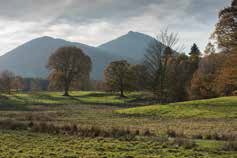articles/Monochrome/mike-mono-page4
Monochrome - choice of the connoisseurs - part 4 of 1 2 3 4 5 6 7 8 9 10 11
by Mike McNamee Published 02/02/2015

The original corrected Raw file and RIGHT the Nikon D700 in-camera translation to toned JPEG for sepia and cyanotype.
Shooting For Monochrome.
Can you shoot monochrome or do you shoot the scene and decide later?
Making a good guess as to how a scene will look when rendered into monochrome can certainly inform the compositional decisions (eg you might ignore a glaring orange distraction in a foreground, safe in the knowledge it will render as a mid-grey mono-tone). Closing your mind to colour and imagining just the effects of line and form is a skill that is being lost in our digital colour world. Filters to put in front of your eye have always been available (typically a Wratten 90) and are still supplied by Tiffen. They are a deep purple colour and gained popularity on the nod of Ansel Adams. However, today's cameras will show you a monochrome (or indeed toned) image right on the back of the camera and so all you are left to deal with are the size and bright light viewing issues of small LCD screens on the back of cameras.
Digital technology really comes into its own in this aspect. The Canon 5D, by way of example, even provides mimics for rendering a scene using complementary filters (these are typically the yellow, orange and red filters beloved of film, mono workers - youngsters ask your granddad!) - if you like what you see on the back of the camera you can even save a copy of the processed file to your camera recording card as a JPEG. ABOVE: Laima Kavaliauskaitehe's entry in the Monochrome category was nominated, and was in the frame right until the end. The judges were impressed with the sinister feel to the image that was very definitely enhanced by the use of monochrome.
Converting under controlled conditions, in Photoshop, using a calibrated system, is always a better option than letting a camera have its head. Also, as you will see later, there remains the option of proving either neutral or toned prints directly through the Epson printer and their Advanced Black and White driver (ABW).
The use of Photoshop also trumps in-camera processing because most creative images are enhanced by the considered use of dodging and burning to lead the eye of the viewer. Dodge and Burn is the simplest of the manipulations you can bring to bear with Photoshop, see Michael Pilkington's article in this issue for the other possibilities.
Converting the Image
It is assumed you will be printing from Photoshop. You might also print from Lightroom but only after the preferred methods of converting have been carried out in Photoshop - unless, that is, you are happy with a default conversion of some description.
In the chart, you can feed a camera-converted mono into Photoshop or convert a Raw file using ACR and feed that without change through Photoshop to the printer. If you go through Photoshop from an RGB file then you have at least seven basic options each with many more sub-options. In the chart, the preferred options are highlighted in green boxes - you are allowed to disagree with this choice. We have not included specialist software such as Tonality or Silver FX but one of the reasons they are popular is because our chart is so big. These specialist programs start by simplifying the conversion but have grown so complex and with so many options that you are really back to square one! One thing they do provide, though, is a gallery of previews.
There is the flexibility to combine the various methods but we will outline a method in which a basic bulk translation is carried out, followed by a refinement stage. Both are not necessarily needed, you could for example prepare your files in ACR and print them out with no individual tonal adjustments. This might be so when a large number of images were involved. The tonal (mainly dodge and burn) refinements might also be carried out between bouts of proof printing if you are meticulously aiming at a single, exhibition-quality, image.
Please Note:
There is more than one page for this Article.
You are currently on page 4
- Monochrome - choice of the connoisseurs page 1
- Monochrome - choice of the connoisseurs page 2
- Monochrome - choice of the connoisseurs page 3
- Monochrome - choice of the connoisseurs page 4
- Monochrome - choice of the connoisseurs page 5
- Monochrome - choice of the connoisseurs page 6
- Monochrome - choice of the connoisseurs page 7
- Monochrome - choice of the connoisseurs page 8
- Monochrome - choice of the connoisseurs page 9
- Monochrome - choice of the connoisseurs page 10
- Monochrome - choice of the connoisseurs page 11
1st Published 02/02/2015
last update 09/12/2022 14:56:43
More Monochrome Articles
There are 9 days to get ready for The Society of Photographers Convention and Trade Show at The Novotel London West, Hammersmith ...
which starts on Wednesday 14th January 2026





